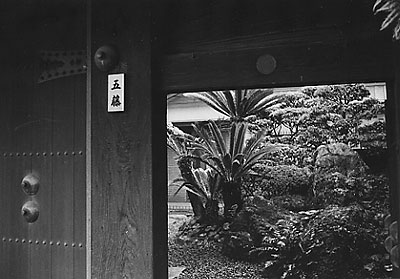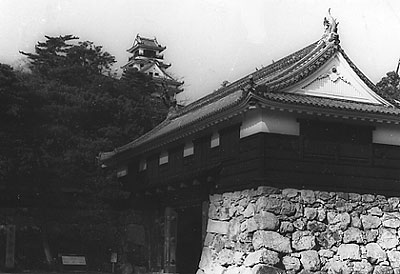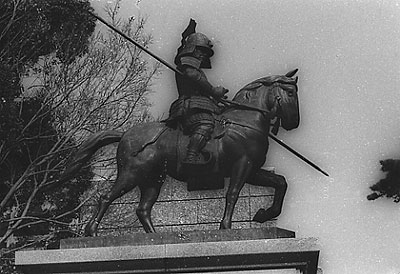February 24
This is a quiet and pleasant time with flowers blossoming
at various places, though it is not at the peak of the springtime flowering
season yet. I walked about 7 kilometers to the west to visit a barbershop
at Tsukanohara today. It was good exercise and I got there earlier than
expected. I used to ride a bicycle over a distance of 37 kilometers to
Geisei spending 3 hours one way. Perhaps I should even try to walk there
next time.
While walking through the old section of the town, you sometimes
find yourself lost in a maze of alleys and come upon unusual, unfamiliar
scenes. I was admiring a delicate white flower growing in the garden of
a house near a reservoir at Asahi-Tenjincho, where I remember I went on
an elementary school outing. Then, I heard someone playing Bach's famous
Fugue in Partia for Violin. Like the famous Jaconne, it was the ultimate
"music of my dream" . I thought it was extremely difficult music
and wondered who in the world was playing it in this old desolate residential
area. Would it be a person like Anton Karas, an unknown guitarist who composed
all the music for the movie "The Third Man"? Would a person like
him be living in this downtown area unnoticed? Even if he is not an internationally
renowned performer like A. Segovia, it would be nice to think that he could
be a yet-unknown master guitarist living here. There may be many able and
talented people in this world who remain undiscovered.
The weather has been bad and with the approach of spring
Kochi will be plagued by cloudy weather. C/2006 A1 (Pojmanski) appears
in the morning skies, but large telescopes housed in a dome cannot be turned
to very low altitudes. It is limited by the height of the track of the
dome. In the past the Dodaira and Kiso Observatories of the University
of Tokyo were not able to observe objects below 10 to 15 degrees above
the horizon. At Geisei Observatory the telescope can be lowered to as low
as 5 degrees above the horizon, but the sluing motor will be automatically
switched off if it exceeds the limit. After all, professional astronomers
would not observe very low altitude objects because they cannot obtain
accurate measurements. As for C/2006 A1, I can afford to wait for it to
rise a little higher as its orbit is becoming more reliable.
Nucleus C of 73P/Schwassmann-Wachmann 3 seemed to have brightened
a little (14.5 magnitude) when observed on February 24 and its tail has
definitely grown. The other nuclei seem to be still very faint.
February 10
I went to Sakawacho town to give a talk to a class of "the
university of longevity" (the University of the 3rd Age). The number
of the elderly over 65 has increased and there are so many organizations
in the prefecture for providing lifelong learning. Their lectures tend
to be planned close to the end of the fiscal year. In fact, there are three
lectures scheduled in February. Interestingly, there are definitely more
women in those lectures. Usually there are about 100 participants at each
meeting and no more than 10% of them are men. Mostly women ask questions,
too.
On my way home I stopped by a community hall and found an
altazimuth telescope in the storage which was a copy of the 20cm comet
seeker used by Mr. Masamitsu Yamasaki. In fact, Sakawacho is the hometown
of Mr. Yamasaki, the first comet discoverer in Japan. From the small hill
where the community hall stands I was able to see the area through a haze
where his home is. It used to be a rural town where the stars were beautiful
in the night sky. However, over the years many houses have been built and
a haze caused by dust and smoke covered the area as well as the foot of
the mountains. The aforementioned telescope was made by members of Yamasaki
Memorial Observatory, but I wonder if the organization still exists. A
staff member of the community hall told me that the observatory would be
opened to the public on request. I guess the activity of the observatory
has declined for years since the return of Halley's Comet. Observatories
tend to decline without able observers.
In the community hall there were the posters in display of
the great historical figures this town had produced: the novelist Uson
Morishita, opera singer Keisuke Shimoyakawa, botanist Tomitaro Makino,
and heroes of the Meiji Restoration, statesmen, and so on. However, I could
not find a photograph of Mr. Yamasaki anywhere. Mr. Yamasaki conducted
research on the earth's latitudinal shifts under the guidance of Dr. Hisashi
Kimura at Mizusawa Latitude Observatory (the present Mizusawa Astrogeodynamics
Observatory) in the 1920s. Around that time he built a unique 20cm comet
seeker rather secretively. The observatory buildings seem to be still standing.
I would like to visit the place someday.
February 1
I strolled along the streets under soft light of early spring.
Kochi experiences very cold days occasionally in winter but spring comes
early. Temperatures are still low, but you can already feel early spring
in the sunshine.
While walking through Obiyamachi, the city's most lively
district, I came across the stately gate of a residence which would remind
you of a daimyo's (or feudal lord's) mansion. The huge name plate on this
ancient gate reads "Goto". From where I stood, I was able to
see the castle of Kazutoyo Yamauchi, the ruler of Tosa (Kochi), overlooking
the town.
There is a famous anecdote about Kazutoyo and Goto. When
Kazutoyo was wounded by an enemy's arrow in the battlefield, one of his
subjects called Goto assisted him. The arrowhead and the thongs worn by
Goto are preserved at the History and Folk Culture Museum at Aki City.
This building in front me was the residence of Goto's descendents. There
were long earthen walls there before, but they were dismantled. Now a bookstore
stands where the walls were. But inside the gate the atmosphere of feudal
days seemed to be preserved with a tranquil landscaped mound.
Mr. Seizo Goto, who donated Geisei's 60cm reflector to Kochi
Prefecture, was born in Aki City and a member of a branch family of the
Gotos. The old house where he was born is preserved in a park in Aki City.
I feel as if it was just yesterday that Mr. Goto and I walked in this neighborhood
looking for a suitable site for a new observatory. I continue to treasure
the 60cm reflector not to waste his generosity. Among the numerous astronomical
facilities Mr. Goto had donated to Kochi Prefecture, which is his hometown,
Geisei Observatory is the only one actively used.

The front gate of the Goto residence

Kochi Castle and Oitemon Gate

A statue of Kazutoyo Yamauchi at a battle field



